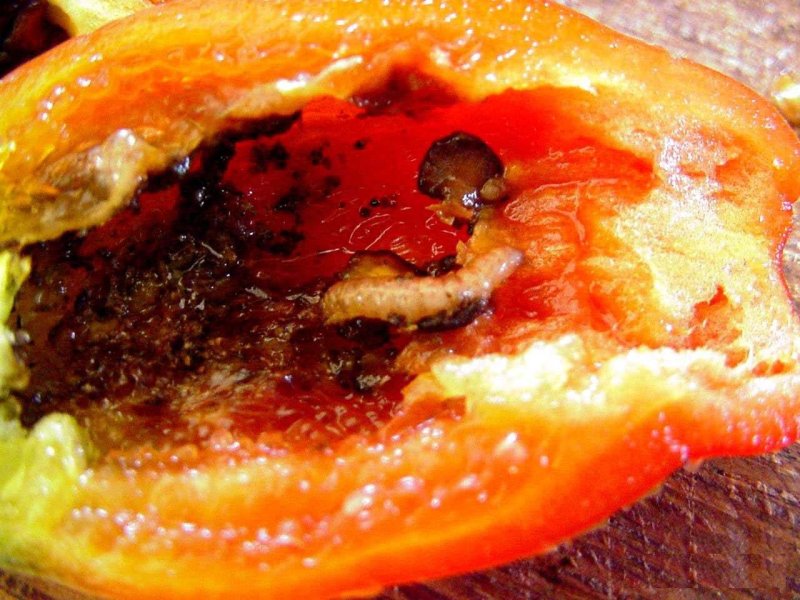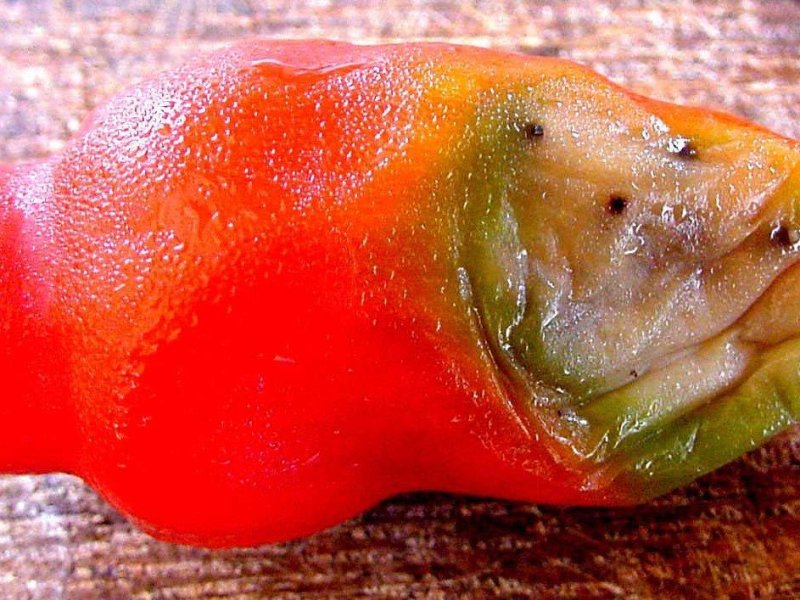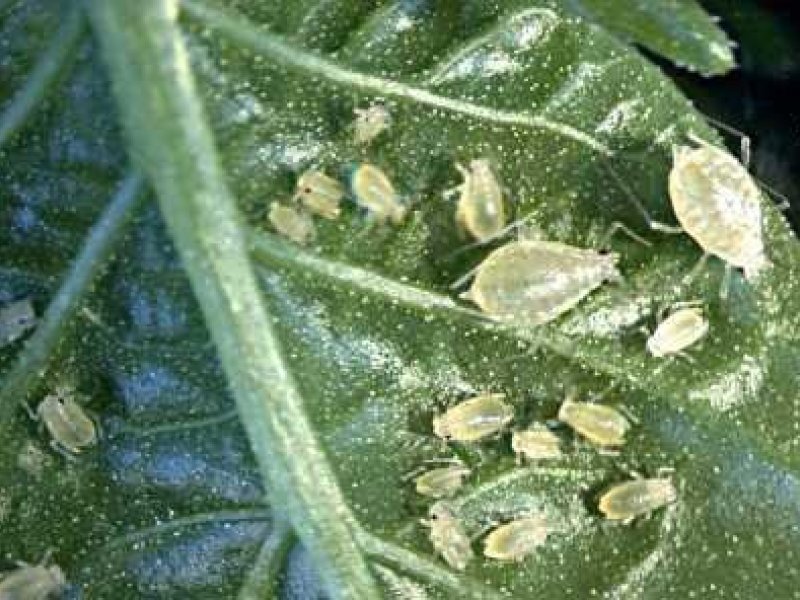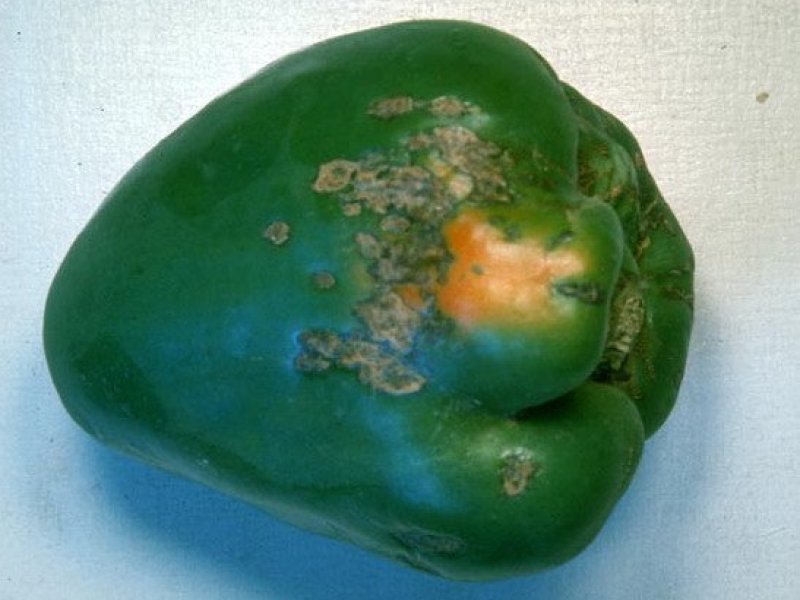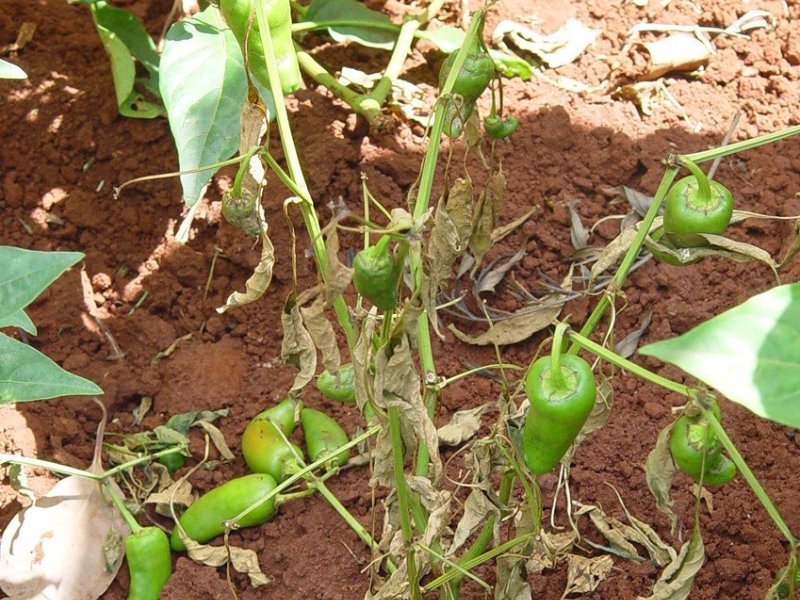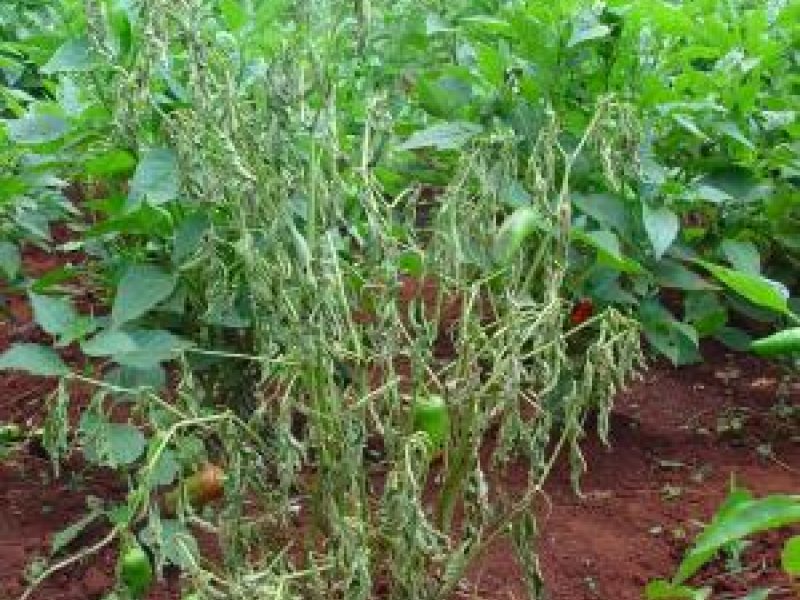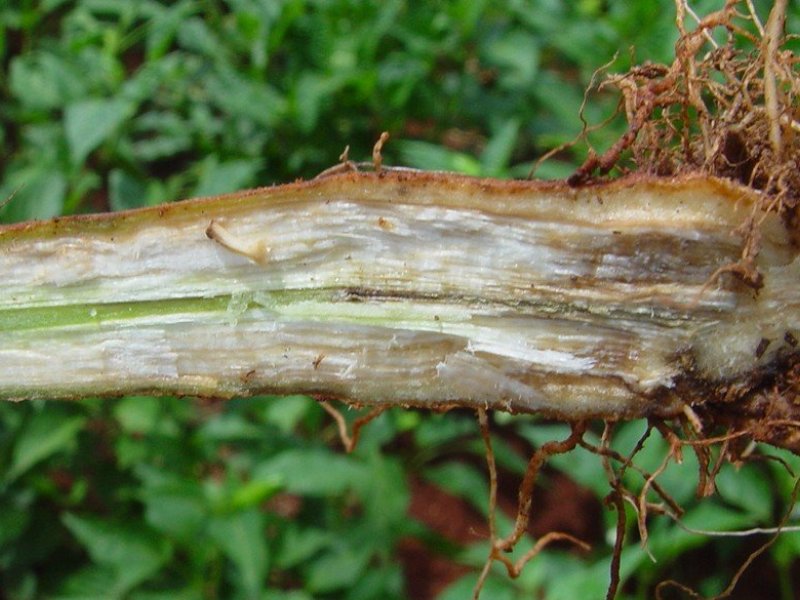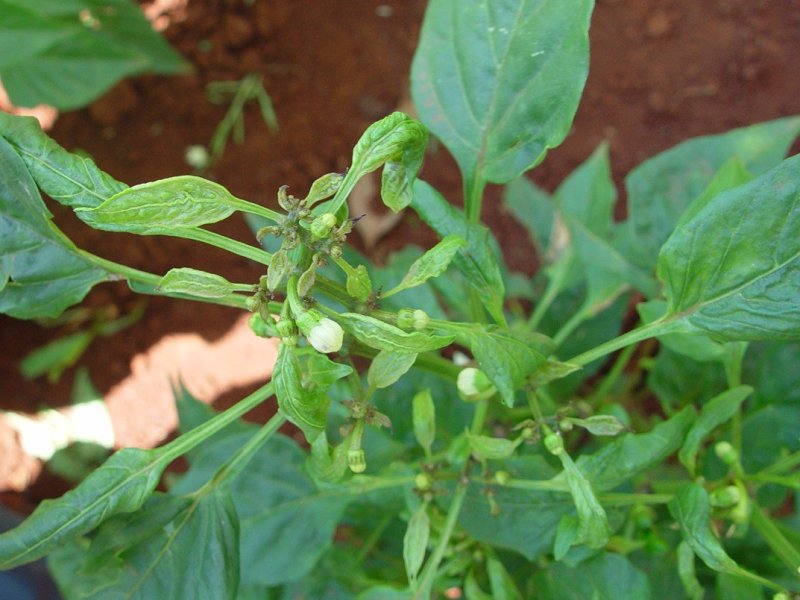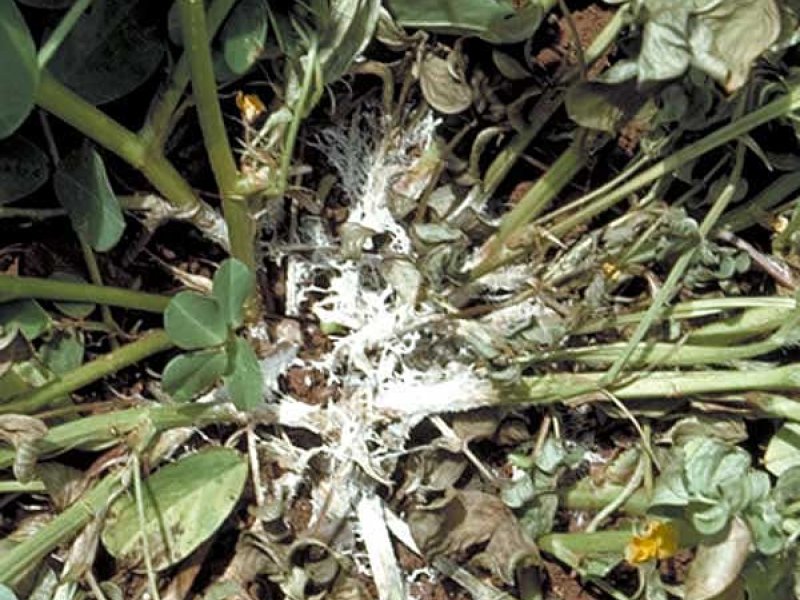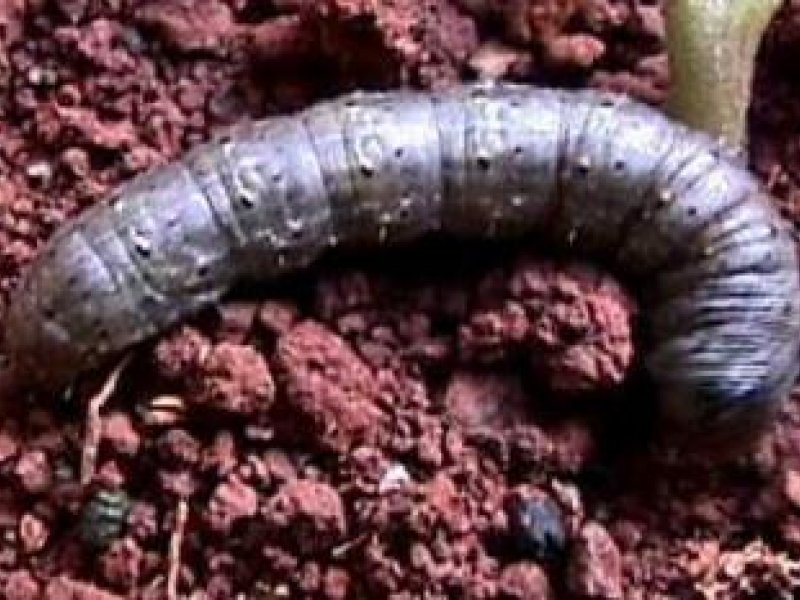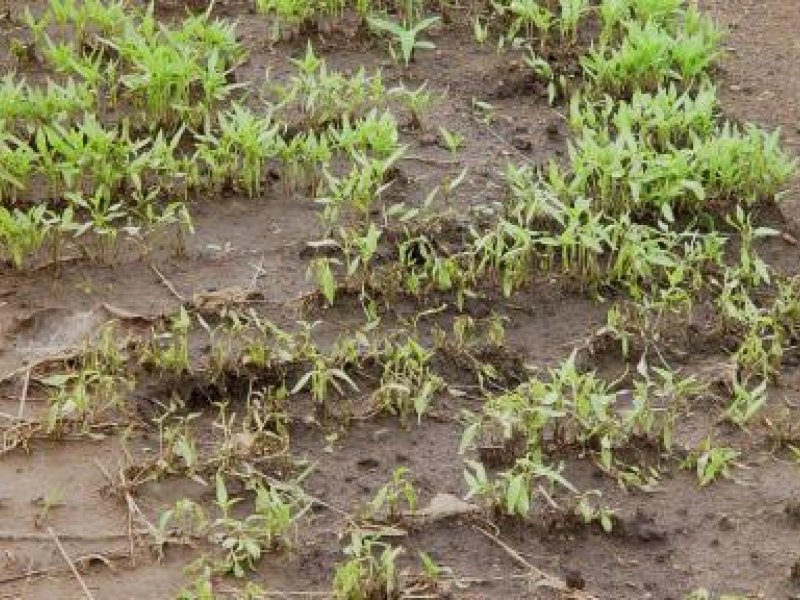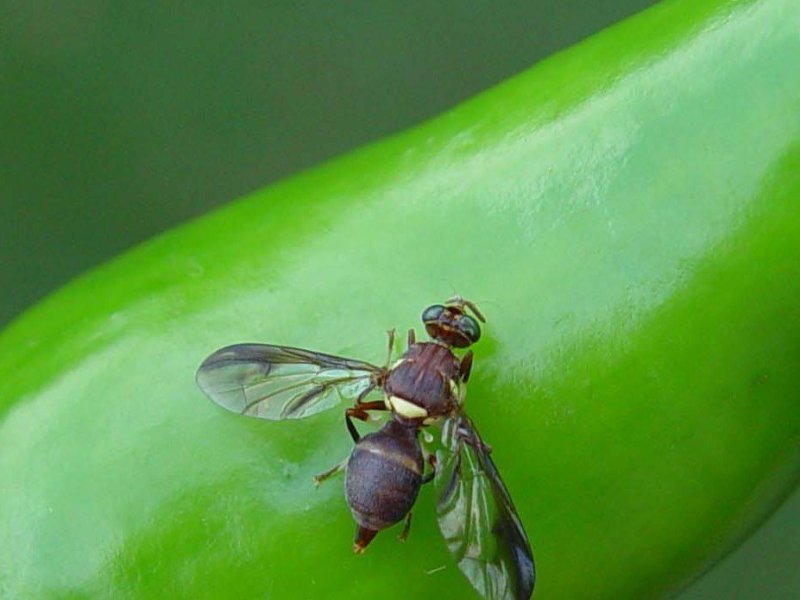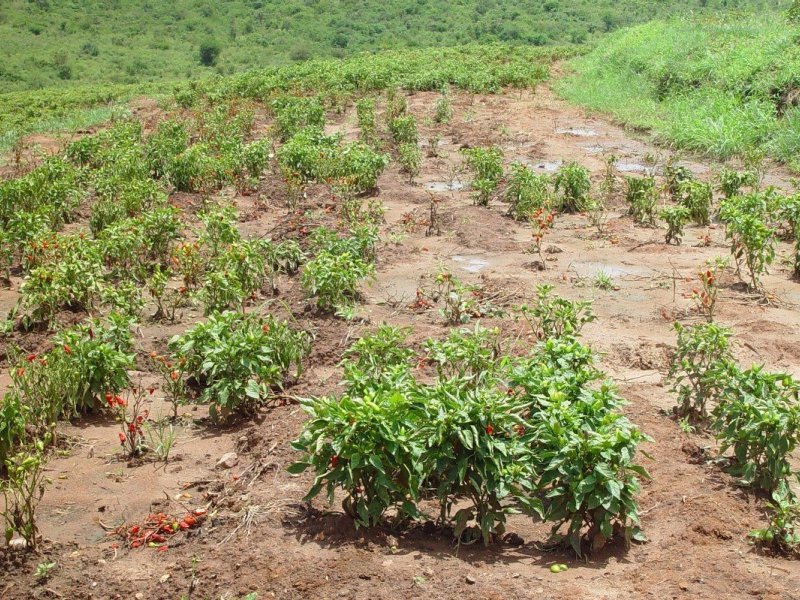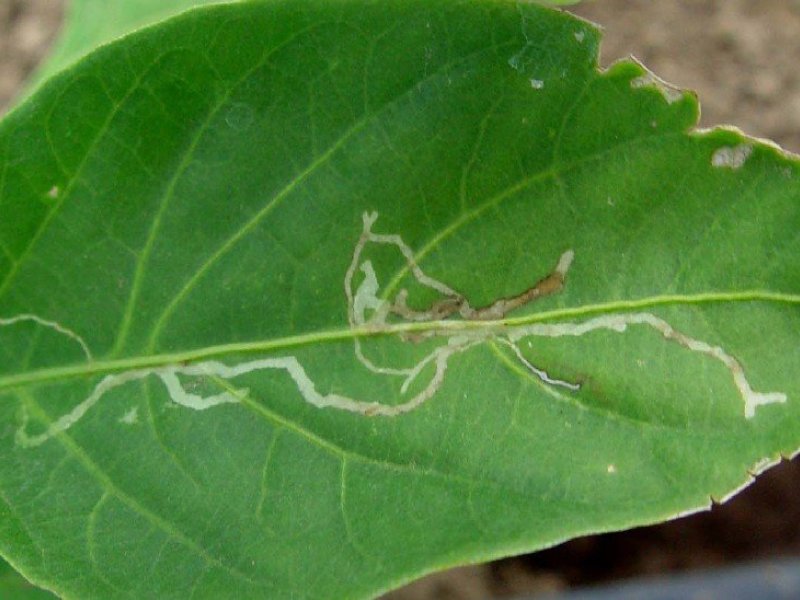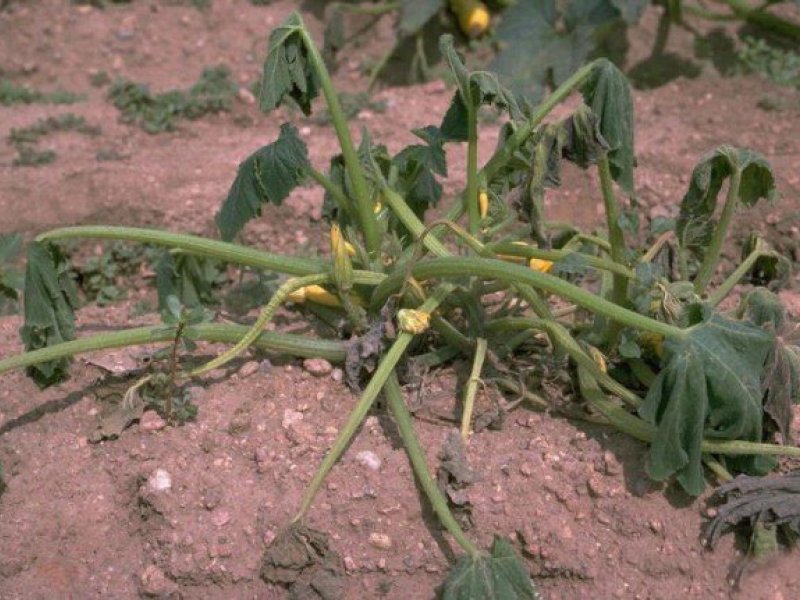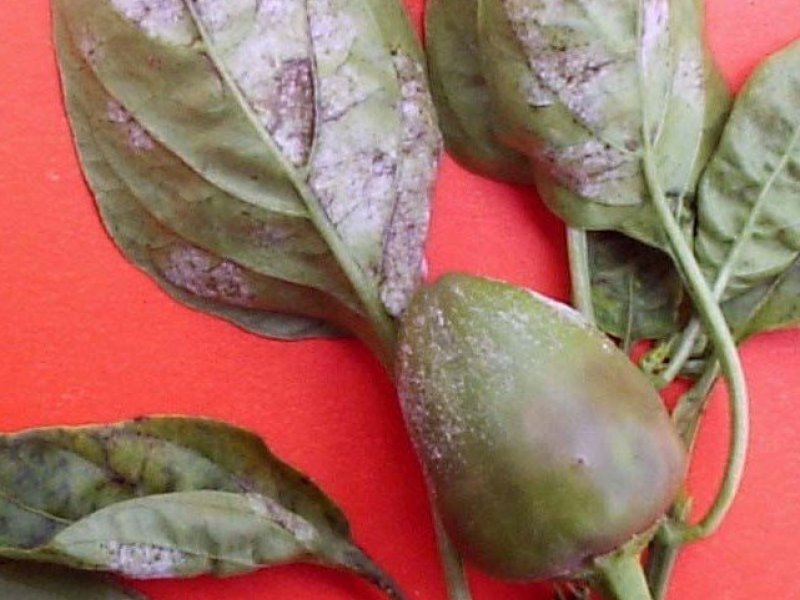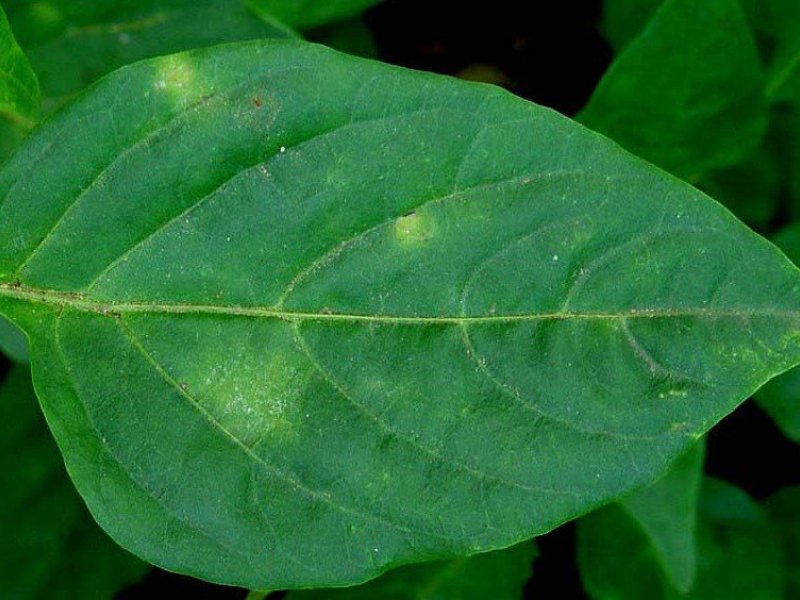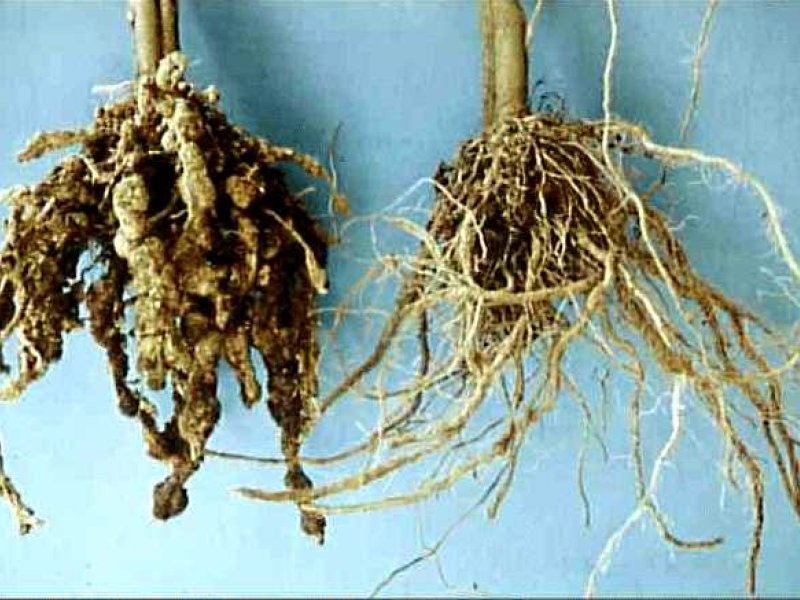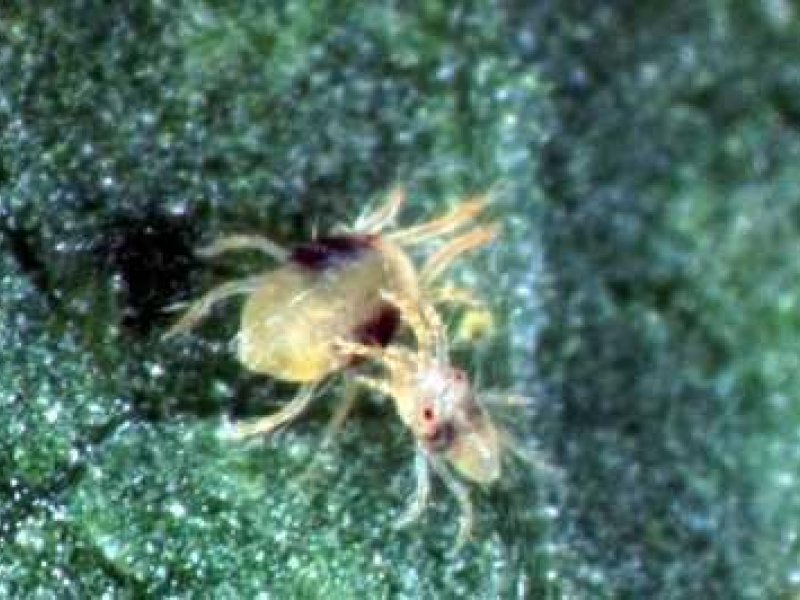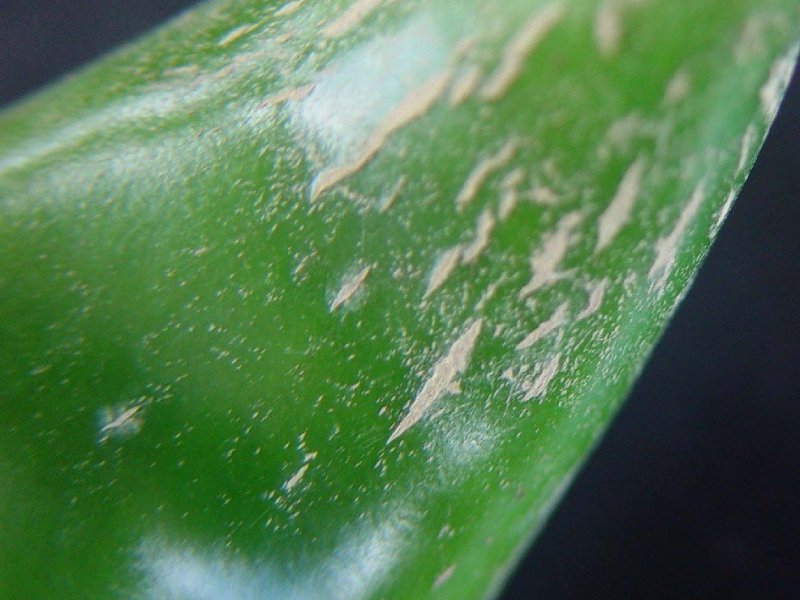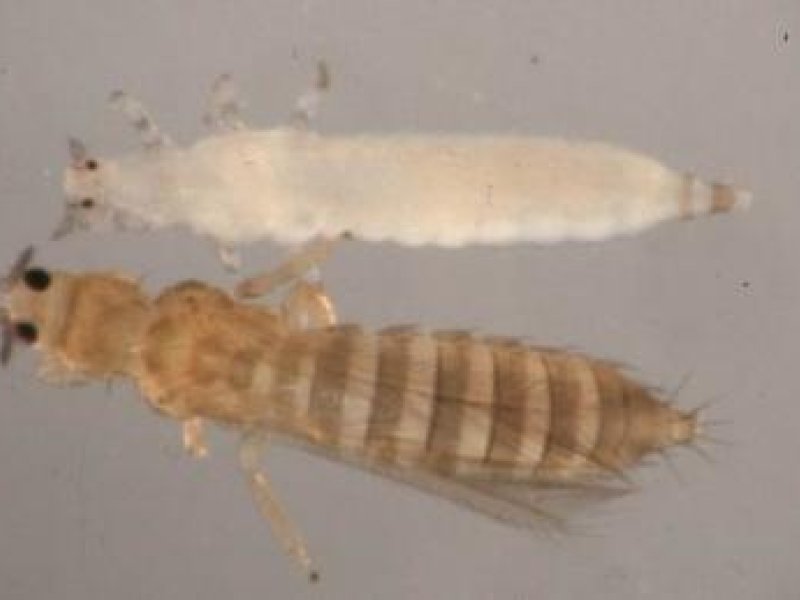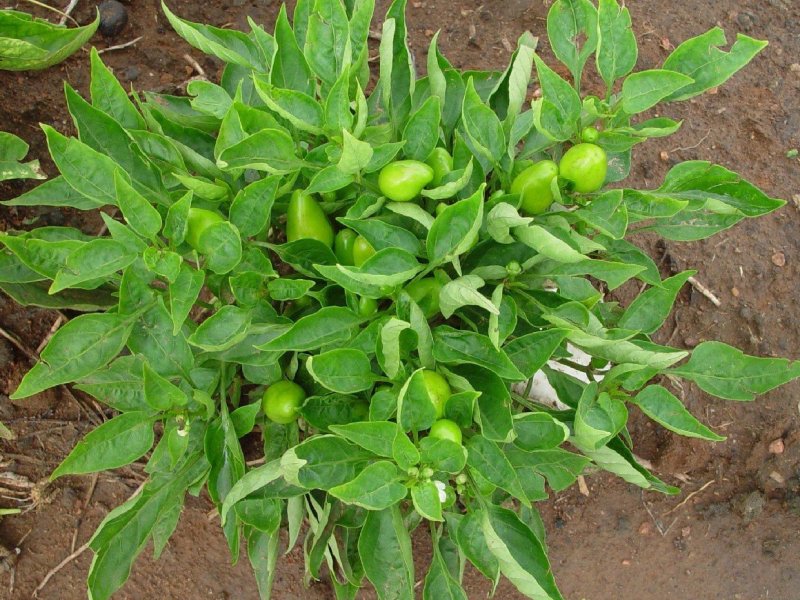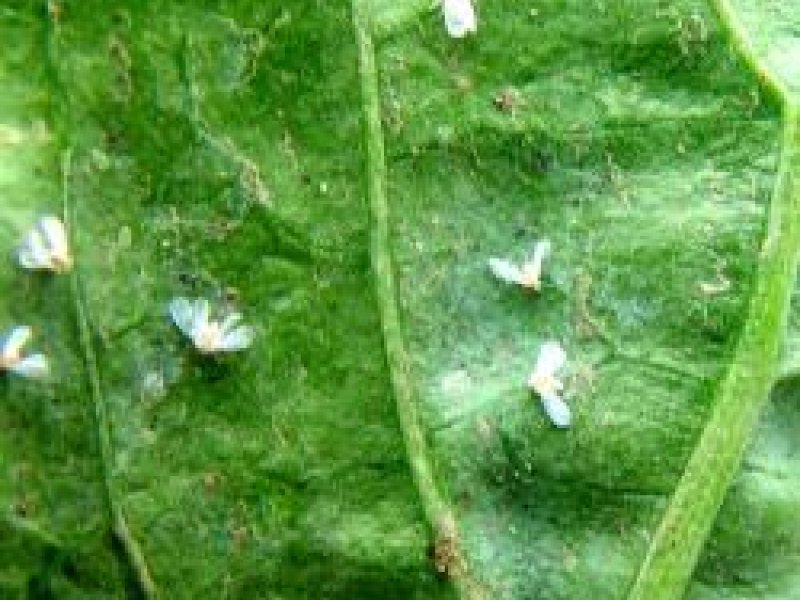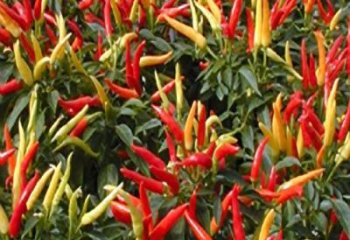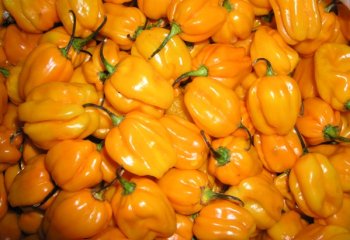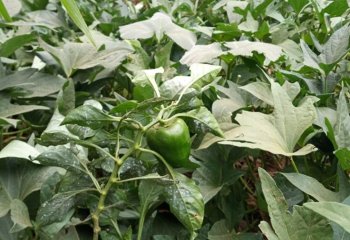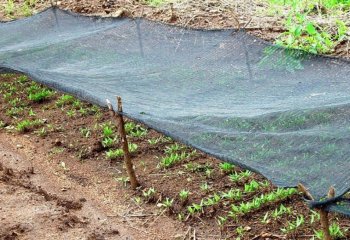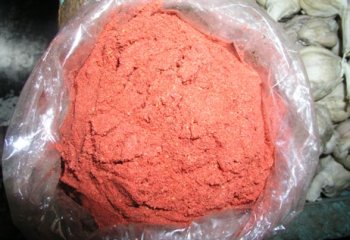|
Fruit borers (Helicoverpa spp.; Spodoptera spp.) Moths of fruitborers are active at dusk and at night, feeding on nectar and laying eggs on leaves. Caterpillars feed on leaves, flowers and fruits. Although severe leaf damage by feeding of African bollworm (Helicoverpa spp.) caterpillars may slow plant growth due to reduced leaf area, caterpillar feeding on leaves is usually of not economic importance. The bollworms are about 2-3.5 cm long.
The main damage occurs on flowers and fruits. Attack on flower buds results in flower abortion. Caterpillars usually bore holes in fruits, causing extensive damage and promoting decay from secondary infection by diseases.
African armyworm (Spodoptera spp.) species are basically leaf-eaters and may cause defoliation when present in large numbers. They also feed on fruits, rendering them unmarketable. |
|
|
What to do:
For more information on neem click here. For information on Bt click here
|
|
Anthracnose (ripe rot) (Colletotrichum capsici) Anthracnose caused by Colletotrichum spp. is a major problem of ripened fruits. The fungus produces dark, sunken spots up to 2.5 cm across on sweet pepper. The spots occur on green and ripe fruits and their surface may be covered in moist weather with salmon-pink mass of spores. The fungus is seed-borne. |
|
|
What to do:
|
|
Aphids (Aphis gossypii, Myzus persicae) Aphids (cotton aphid and green peach aphid) occur in colonies initially around tender plant parts (growing points, young stems and leaves, flower buds) and on the lower leaf surface. When numerous they can be found on all above ground parts of the plant. Aphids damage plants in three ways: by sucking their sap, excreting a sticky substance (honeydew) that coats the plants, or/and by transmitting viral diseases.
Feeding by aphids causes distortion (curling, wrinkling or cupping) of young leaves, chlorotic spotting and mottling of older leaves, and may lead to stunting and wilting of plants. Growth of sooty mould on honeydew excreted by aphids reduces photosynthesis and affects fruit quality.
Aphids cause indirect damage as vectors of important viruses such as alfalfa mosaic, chilli veinal mottle, cucumber mosaic, pepper mottle, pepper severe mosaic, pepper veinal mottle, potato Y and tobacco etch virus.
|
|
|
What to do:
|
|
Bacterial soft rot (Erwinia carotovora pv. carotovora) Soft rot often begins in the peduncle and calyx tissues of harvested fruit. Infection can occur through wounds anywhere on the fruit. Fruit infected on the plant collapses and hangs on the plant like a water-filled bag. When the contents leak out, a dry shell of the fruit remains.
The bacteria are soil-borne. Soft rot is primarily a post-harvest problem although it can occur in the field being facilitated by injuries to the fruit by insects and water splash. The disease is serious during rainy periods because the bacteria are splashed from the soil onto the fruit, which are more susceptible due to their high moisture content.
|
|
|
What to do:
|
|
Bacterial spot (Xanthomonas campestris pv. vesicatoria) Leaves, fruit and stems can be attacked by the disease. Leaf spots begin as circular, water-soaked that become necrotic with brown centres surrounded by yellowish borders. The spots are sunken on the upper leaf surface and slightly raised on the lower surface. On stems spots are elongated. Affected leaves turn yellow and drop. Affected fruits have raised brown spots that are wart-like in appearance. The disease has a wide distribution wherever peppers are grown. It spreads rapidly during warm, rainy conditions. High relative humidity with free moisture on leaves for long periods favours infection. Ideal temperatures for infection are above 20°C . The bacterium is seed-borne and survives in crop debris.
|
|
|
What to do:
|
|
Bacterial wilt (Ralstonia solanacearum) The disease occurs in scattered plants or groups of plants in the field. Characteristic symptom is wilting of the entire plant with no leaf yellowing. Cross sections cut from roots and lower stems of diseased plants exude milky streams of bacteria from the vascular system when suspended in water. The bacteria have a wide host range and can survive in the soil for long periods. The disease is favoured by wet, warm conditions. Peppers are not as susceptible as eggplants, potatoes, tobacco or tomatoes. Rotation is not effective as the pathogen can survive for a long period - several years - in the soil and also attack a wide range of crops and solanaceous weeds.
|
|
|
What to do:
|
|
Broad mite or yellow tea mite (Polyphagotarsonemus latus) Broad mites are tiny (0.1-0.2 mm long) and cannot be seen with the naked eye, and are even difficult to detect with a hand lens. An attack by the broad mites can be detected by the symptoms of damage. They live on the underside of leaves, tender stems, fruits, flower peduncles and flowers. Their feeding produces discolouration, necrosis of tissues and deformation. Initial attack occurs on the stems of terminal shoots and the lower surface of young leaves.
Young leaves turn narrow, twisted or crumpled, fail to elongate and finally may wilt and dry, giving the plant a scorched appearance. Older leaves are generally cupped with corky brown areas between the main veins on the lower side of the leaves. The succulent part of the stem of young plants may become slightly swollen, roughened or russeted. The foliage becomes rigid. Attacked fruits become deformed with a cork-like surface or fail to develop. Severely infested fruits fall, and yield is significantly reduced. Symptoms remain for a long period of time after control.
|
|
|
What to do:
|
|
Cercospora leaf spot (Frogeye) (Cercospora capsici) Spots on leaves are brown and circular with small to large light grey centres and dark brown margins. Spots on stems, petioles and peduncles are typically elliptical and also have light grey centres with dark borders. Infected leaves are shed. Extensive defoliation occurs under severe disease pressure. Fruits are not attacked. The fungus survives on seeds and in crop debris. The disease is favoured by prolonged periods of wetness.
|
|
|
What to do:
|
|
Collar rot (Sclerotium rolfsii) It is a common and destructive disease of peppers widespread in the tropics. The fungus attacks the stem at ground level eventually girdling and killing it. White fungal growth usually is visible on the base of the stem and on the soil line around the base of the plant. On the white fungal mat, sclerotia (resting fungal spores) about the size of mustard seed that are tan to brown when mature are produced. High soil moisture and temperatures (30-35°C ) favour disease development. Symptoms are more severe during dry conditions following a wet period. The fungus has an extremely broad host range and it is also a good saprophyte.
|
|
|
What to do:
|
|
Cutworms (Agrotis spp., Spodoptera spp.) Cutworms are the caterpillars of various moths, belonging mostly to the genus Agrotis. Young caterpillars feed on leaves making small holes. After few days they drop to the soil where they live until pupation. Caterpillars remain in the soil during the daytime coming out at night to feed. They cut stems of young seedlings at the level of the soil, killing them and affecting establishment of the crop. Some Spodoptera species, in particular S. littoralis act sometimes as cutworms. Caterpillars, in particular under hot conditions, hide during the day in the soil around the base of the plants, and may cut them, especially seedlings, at the base of the stem. At night they climb into plants to feed.
|
|
|
What to do:
|
|
Damping-off and root rot (Rhizoctonia solani / Pythium spp. / Fusarium spp. Seedlings fail to emerge (pre-emergence damping-off); small seedlings collapse (post-emergence damping-off); seedlings are stunted through root rot and / or collar rot. Nursery beds show irregular patches. The fungi causing seedling diseases are soil inhabitants. Pythium spp. are favoured by low temperatures while R. solani and Fusarium spp. thrive at higher temperatures. |
|
|
What to do:
|
|
Fruit flies (Ceratitis spp., Bactrocera spp., Dacus spp.) Fruit fly females lay eggs under the epidermis of the fruit. After emerging from eggs maggots generally move to the core to feed, but they may also feed on the walls of the fruit. This causes secondary rot and premature fruit fall. An infested fruit usually has a small dimple where the female fly deposited an egg. As the maggot matures inside the fruit, the fruits turn red prematurely, becoming soft and rotten. Soft spots can often be seen where the maggot has fed on the fruit. When infested fruit is picked, the cap usually separates from the fruit because the maggot has eaten the core. Fruit may drop from the plant. Maggots remain in peppers until fully grown (from 2 to 3 weeks). At this time the maggot leaves the pepper, drops to the soil to pupate. Yield losses can be considerable. One maggot can destroy an entire fruit.
|
|
|
What to do:
|
|
Fusarium wilt (Fusarium oxysporum f.sp. capsici) Disease symptoms include drooping and yellowing of lower leaves followed by wilting of the entire plant. Leaves on infected plants remain attached and the vascular system of the plant is discoloured, particularly in the lower stem and roots. The fungus lives indefinitely in the soil and is spread in irrigation water. It is very susceptible to changes in temperature and soil moisture. The optimum temperature for disease development is 24 to 27°C . Soil moisture has the greatest influence. The wilt does not occur in dry soil, but it is serious in poorly drained fields.
|
|
|
What to do:
|
|
Leafmining flies (Leafminers) Liriomyza spp. Female flies make numerous small, whitish punctures on the foliage when feeding and depositing eggs. These punctures can serve as entry points for disease-causing organisms such as bacteria and fungi. The eggs hatch into tiny yellow maggots that feed on leaf tissues leaving a wandering track known as mines. Full-grown maggots come out of the mines to pupate in the soil beneath the plants or on the foliage. Maggots are the most destructive stage. The mines may reduce photosynthetic activity, affecting development of flowers and fruits. In severe infestation, the leaves might be completely mined, dry and fall off prematurely, causing loss of vigour and turgidity of the plant. This may eventually result in wilting, in particular in warm weather, leading to yield loss, fruit sunscald, or in serious cases death of the plant, especially of young pants.
|
|
|
What to do:
|
|
Phytophthora blight (Phytophthora capsici) All parts of the pepper plant can be affected. Seedlings can be killed. Collar rot and wilt phase is most common and is characterised by a dark brown stem discolouration extending upward from the soil line accompanied by a sudden wilt of the entire plant. Upper stem lesions (spots) are also dark brown and occur primarily at branch points causing death of branches above the lesions. Leaf spots are round or irregularly shaped, dark green and water-soaked. They later dry and become light tan.
Fruit infection begins as water-soaked, dull green spots that expand rapidly to cover the entire fruit. Later the fruits become flaccid and wrinkled but do not detach from the affected plants. The host range of the fungus includes cucurbits, eggplants and tomatoes. The fungus can survive on and in seeds, in soil and in crop debris. The collar rot and wilt phase is most severe in over-irrigated or poorly drained fields. Aboveground infection is associated with extended periods of rainfall or overhead irrigation. |
|
|
What to do:
|
|
Powdery mildew (Leveillula taurica) Yellowish blotches or spots appear on the upper leaf surface. The leaf surface is covered with a white to grey powdery fungal growth. The disease progresses from the older to younger leaves and shedding of the foliage is pronounced. Leaf defoliation leads to reduction in size and number of fruits. It also results in fruits being sun-burned. The disease is favoured by warm, humid and dry weather. The fungus causing powdery mildew also attacks eggplants and tomatoes. Overhead irrigation reduces disease severity.
|
|
|
What to do:
|
|
Root-knot nematodes (Meloidogyne spp.) Symptoms of infestation by root-knot nematodes are similar in all crops: wilting of plants and if infested plants are pulled from the soil the roots can be seen to be distorted, swollen and bearing knots (galls). The galls on pepper are much smaller than those on cucurbits or tomatoes. The infested roots eventually rot and affected plants die.
|
|
|
What to do:
|
|
Spider mites (Tetranychus spp.) Spider mites suck the sap of the plants, causing mottling of the upper leaf surface. Infested leaves first show a white to yellowing speckling, and then eventually turn bronze and fall off as the infestation becomes heavy. Spider mites prefer the lower surface of the leaves, but in severe infestations occur on both leaf surfaces as well as on stems and fruits. High infestations cause defoliation.
|
|
|
What to do:
|
|
Thrips (Frankliniella spp., Scirtothrips dorsalis, Thrips tabaci) Thrips usually feed on all above ground parts of plants, preferring the underside of young leaves, flowers and fruits. Often they are concealed under the calyx. Plant damage results from thrips puncturing leaves and sucking the exuding sap. At the initial stage of infestation leaves have a silvery sheen and show small, dark spots of faecal material on the underside. When the attack increase leaves curl upward, wrinkle and finally dry up. This may predispose fruits to sunscald.
Heavy feeding damage turns leaves, buds and fruits bronze in colour. It may cause wilting, retardation of leaf development and distortion of young shoots resulting in stunted plants. Attack on fruits causes deformation and scarring (manifested as brown lines) of the fruits making them unmarketable, especially fruits for the export market. Thrips attack at the seedling and early stages of the crop delays crop development. Thrips transmit the tomato spotted wilt virus in peppers. S. dorsalis transmits the leaf curl disease of chillies.
|
|
|
What to do:
|
|
Viral diseases About 17 viruses have been reported to attack peppers. Those considered economically important in Africa include alfalfa mosaic, chilli veinal mottle, cucumber mosaic, pepper veinal mottle, potato Y, tobacco etch, tobacco mosaic, tomato spotted wilt and chilli leaf curl. Most of these viruses are transmitted by insects, infected seed and a few by mechanical means. The first six above listed viruses are spread by aphids; tobacco mosaic is mechanically transmitted and infected seed; tomato spotted wilt by thrips; and chilli leaf curl by whiteflies.
Viral diseases are particularly difficult to firmly diagnose by symptoms because there is so much overlap in symptomatology. Furthermore, symptom expression can be altered by many factors among which are cultivar, age of host plant, environmental conditions, host plant nutrition, and viral strains, not to mention the occurrence of virus mixtures. General symptoms include mosaic patterns on leaves, yellowing , ring spots, leaf deformation or distortion, curling of leaves, and/or stunting of plants. They may also cause reduction of fruit size, distortion, and/or ring patterns.
|
|
|
What to do:
|
|
Whiteflies (Bemisia tabaci, Trialeurodes vaporariorum) Whiteflies damage plants in three ways. Whitefly immature stages (nymphs) and adults suck sap from leaves. Their feeding, in addition to removing plant nutrients, produces chlorotic spots on infested leaves. Nymphs excrete a clear sugary liquid known as honeydew, which often completely covers the leaves during heavy infestation. Honeydew supports the growth of a black sooty mould, and as a result the leaves may turn black, affecting photosynthesis. Whiteflies are vector of important viral diseases such as chilli leaf curl, tiger disease, Serrano golden mosaic, and Texas pepper geminivirus.
|
|
|
What to do:
|
Geographical Distribution in Africa
Geographical Distribution of Peppers in Africa. Updated on 10 July 2019. Source FAOSTAT
Capsiccum annum geographical distribution table. © OpenStreetMap contributors, © OpenMapTiles, GBIF. https://www.gbif.org/species/2932944
Read more
Local Names (Detailed)
Angola: (omu) ndungu (Umbundu); Ndungu (Umbundu); Pimento, Ppimentao-Da-Caiene (Portuguese) c
Benin:Takin (Fon, Goun); Yédésé (Gèn); Ata Oyibo (Yoruba); Piment (Fench) (Koné et al., 2019)
Burundi: Ipiripiri (Kirundi)
Central Africa: Ndongo (Sango).
DRC: Ndongaya Assuêlê (Mbössi); Gros Piment (French); Ndongo (Akwa); Dongo (Aka, Envele); Nlungu (Kikongo); Makaya Ma Nuungu, N'nuungu (Laadi), Nunga (Beembe); Ndungu (Kiyaka); Pili Pili (Lingala); Kani Buseu (Wolof); Ndongo (Akwa; Djengete (Mono), Pilipili (Lingala), Tandala (Ngwaka), Lolo Gbendu (Kuala) (Koné et al., 2019).
Ethiopia: Karia / Keto (Amharic); Mitmitta (Amarinya); Mitmita (Amhara); Berbere (Sheko) (Koné et al., 2019)
Gabon: Okam (Fang), Andu (Mindumu), Ntogolo (Myéné), Petit Piment, Pili-Pili (French) ((Koné et al., 2019).
Guinea bissau; Sinmeti (Balanta), Burébé (Planta), Mantébé (Fruit) (Biafada), Teébè (Bijagó), Malaguêta, Piripiri (Guinean Creole), Nhamaco (Futa-Fula), Guilè (Fula), Idúu (Manjaco), Malakete (Nalu), Piripiri, Malagueta (Portugese) (Koné et al., 2019).
Kenya: Pilipili (Swahili); Ndulu (Kamba Machakos), Nyaika (Kitui Kamba)
Mali: Keepel "Tengi Soo" (Kokodjougou) ((Koné et al., 2019).
Morocco; Sûdâniya, Felfel Hârr (Moroco), Piment Enragé, Pimen De Cayenne (Local French) (Koné et al., 2019).
Niger: Bar kono; Barkhanou (Hausa); Tonko (Zarma); Petit Piment, Pilipili (Local French) (Koné et al., 2019).
Nigeria: Ata-Pupa, Ata-Nla, Atarodo (Yoruba); Ata Wewe (Yoruba), Ose/Totashi (Igbo), Barkono (Hausa); Ata wewe (Owomode) (Koné et al., 2019).
Rwanda: Urusenda (Koné et al., 2019).
Sierra leone; Hua-wuyei (Cibemba) (Koné et al., 2019).
South Africa: Tshilisi (Xhosa), Chili (English) (Koné et al., 2019).
Togo: Kami (Gurmantché), Gros Piment (French); Yébéssévi (Mina), Atadévi, Atadésue (Ewé), Pilipili, Petit Piment, Piment Enragé (French) (Koné et al., 2019).
Uganda: Kamurari (Luganda), Eshenda (Runyankole) (Koné et al., 2019).
General Information and Agronomic Aspects
Introduction
Capsicum peppers (mainly Capsicum annuum, Bell pepper and capsicum frutescens, Chilli pepper) are the most popular and most widely used condiment all over the world. The genus Capsicum consists of all the ‘chilli pepper plants’ with 3-5 wild species and over 2000 cultivars. Its fruits are consumed in fresh, dried or processed form as table vegetable or spice. Capsicum peppers are extensively pickled in salt and vinegar. Colour and flavour extracts are used in both the food and feed industries, for example, ginger beer, hot sauces and poultry feed, as well as for some pharmaceutical products. Sweet, non-pungent capsicum peppers are widely used in the immature, green-mature or mature-mixed-colours stage as a vegetable, especially in the temperate zones. Capsicum extracts show promise against some crop pests.
Pepper (Capsicum annuum), belongs to the family Solanaceae and the Capsicum genus. There are approximately 30 species within the genus Capsicum, which includes a wide variety of pepper plants. C. annum includes both mild (sweet peppers e.g. Bell pepper) and spicy peppers (chilies). Other notable cultivated species within the genus include: C. frutescens (e.g. Tabasco peppers & bird's eye chili, C. chinense (extremely hot peppers. Eg. ghabanero and Scotch bonnet), C. pubescens, and C. baccatum (e.g aji amarillo and aji rocoto). Of these species, Capsicum annum is the most economically significant crop due to its spicy aroma and flavor.
Capsicum annuum is native to South America specifically in regions of Mexico, Central America, and South America. Today, it is cultivated and grown worldwide in both tropical and temperate regions, including North and South America, Asia, Africa, and Europe. In Africa, hot pepper is considered a traditional vegetable or spice, while sweet pepper is considered exotic in temperate regions.
Sweet pepper thrives in temperate climates and is essential in Western industrialized nations. Conversely, hot pepper usually prefers warmer conditions. While some hot pepper types, like aromatic hot pepper, can adapt to temperate climates, bird pepper grows too slowly for outdoor cultivation in such conditions.
Capsicum peppers are versatile crop used as condiments in various cuisines globally. Its fruits are consumed in fresh, dried or processed form as table vegetable or spice. Sweet peppers are widely used in the immature, green-mature or mature-mixed-colors stage as a vegetable, especially in the temperate zones. In contrast, chili peppers are primarily used to spice up dishes and create hot sauces and salsas. Chilies are available in a range of different forms, such as frozen, canned, dried (either in whole or crushed form), and pickled. They can also undergo various processes to create fermented goods, powders, sauces, curry pastes, and salsas. Dried chilies are frequently turned into powders for cooking purposes, and both fresh and dried chilies are utilized in the production of hot sauce. Furthermore, Capsicum leaves can be consumed and are incorporated into soups and stews.
C. annuum is a rich source of vitamins, especially vitamin C, which is essential for the immune system. It contains dietary fiber, antioxidants, and other vitamins and minerals. The compound capsaicin found in hot chili peppers may have potential health benefits, including pain relief, improved metabolism, and appetite control. Top global producers of Capsicum annuum include China, India, Mexico, Indonesia, and Turkey. In Africa, countries like Nigeria, Egypt, and South Africa are significant producers of C. annuum.
(Grubben et al., 2004, Swamy, 2023)
Species account
Capsiccum annum (Bell/ Sweet peppers)
Sweet peppers plants are perennial, short bushes with woody branching stems growing to a height of upto 1m. Leaves: broad, dark green, and lance-shaped, with serrated edges. Flowers: white or purple bell-shaped flowers which are 2.5 cm (1 in) in diameter. Fruits: thick and fleshy fruit walls, which are typically bell-shaped, though they can also be elongated or blocky in shape. come in a range of vibrant colors, including red, green, yellow, and orange.
Sweet peppers have a mild taste due to their low capsaicin content, making them suitable for salads, stuffing, and various culinary applications where a mild, non-spicy taste is desired. The crops are perennial but are normally grown as annuals in temperate regions for only one growing season.
(Plant village n.d, Swamy, 2023)
© Maundu P, 2021
Cultivars commonly grown in Kenya:
Sweet pepper (C. annuum):
- California Wonder
- Yolo wonder
- Emerald Giant
- Ruby Giant
Hot pepper
- Anaheim
- Fresno
- Jalapeno
- Long Red Cayenne
- Rocket
- Short Bullet
Ecological Information
Climatic requirements and cultural practices for production of sweet peppers and chillies are the same. They also share a same complex of pests and diseases. Capsicum peppers tend to tolerate shade conditions up to 45% of prevailing solar radiation, although shade may delay flowering. Capsicum peppers grow best on well-drained loamy soils at pH 5.5-6.8. They grow at a wide range of altitudes, with rainfall between 600 and 1250 mm. Severe flooding or drought is injurious to most cultivars. Seeds germinate best at 25-30°C. Optimal temperatures for productivity are between 18 and 30°C. C. frutescens are more tolerant to high temperatures. Cooler night temperatures down to 15°C favour fruit setting, although flowering will be delayed as temperatures drop below 25°C. Flower buds will usually abort rather than develop to maturity if night temperatures reach 30°C. Pollen viability is significantly reduced at temperatures above 30°C and below 15°C.
Agronomic aspects
Capsicum peppers are propagated by seed. Seeds should be harvested from mature fresh fruit after 2 weeks of ripening after harvest. Seeds remain viable for 2-3 years without special conservation methods if they are kept dry. They rapidly lose viability if they are not properly stored especially at high temperature or humidity. Seed dormancy may occur to a small extent, especially if seed is harvested from under-ripe fruits. Some 200-800 g of seed is required per ha, depending on plant density. When using own seeds, hot-water treat the seeds.
For information on hot-water treatment of seeds click here.
Seedbeds are usually covered with straw, leaves or protective tunnels. For better production, seedlings should be transferred to seedling pots (plastic pots, paper cups, banana leaf-rolls, etc.) when the cotyledons are fully expanded. Transplants are planted out in the field at the 8-10 true leaf stage, usually 30-40 days after sowing. Hardy transplants can be produced by restricting water and removing shade protection, starting 4-7 days before transplanting. Transplanting should be done during cloudy days or in the late afternoon, and should be followed immediately by irrigation. Direct sowing in the field is practised to a limited extent. Capsicum peppers are well adapted to sole cropping and intercropping systems. Capsicum peppers are often relay-cropped with tomatoes, shallots, onions, garlic, okra, Brassica spp. and pulses. They also grow well among newly established perennial crops.
© Maundu P, 2006
Husbandry
Capsicum peppers thrive best if supplied with a generous amount of organic matter. A reasonable recommendation is to supply 10-20 t/ha of organic matter. General nutrient requirements are 130 kg/ha of N, 80 kg/ha of P and 110 kg/ha of K. Nutrient availability is subject to soil type and environmental conditions, so local recommendations vary. Manual weeding is usual for weed control. It is most critical at the reproductive phase. Organic or plastic mulches are very effective for weed control, and reflective mulches help to minimise insect vectors of plant viruses. Staking can help minimise lodging. Capsicum peppers may be grown under rain-fed or irrigated conditions. To avoid certain diseases, pests or allelopathic damage, capsicum peppers should not be planted after other solanaceous crops, sweet potato or jute.
Harvest, post-harvest practices and markets
Harvesting
Peppers are typically ready for harvesting approximately 2 months after transplanting, though the exact timing can vary based on the pepper types, season and the fruit maturity desired. Harvest maturity is determined using various criteria which vary based on the pepper types. The most common indicator of fruit maturity is the size of the pepper which should be fully developed, reach its expected size for the particular variety, and exhibit a frim, thick wall and a shiny skin. Green fruits are mature when firm, if gently squeezed they make a characteristic popping sound.
The pepper's external color is another important indicator. The decision on when to harvest depends on market color preferences. Sweet capsicum peppers are often harvested at the green mature stage, although sometimes they are harvested red. Assorted fruit colors such as yellow, orange, chocolate and purple are also available in specialized markets. Hot capsicum peppers are harvested green or red depending on their utilization. For the fresh market, fruits are harvested mature but firm, whereas capsicum peppers sold as dried pods may be left to partially dry on the plants before harvesting.
Harvesting is done by hand, gently holding the fruit and snapping it off the plant or using a small knife. The fruits are harvested once per week preferably in the cooler hours of the day. Avoid harvesting when peppers are wet to prevent decay. Remove peppers with skin injuries and any diseased fruit separately from the healthy ones. Use wide, shallow, stackable plastic containers with smooth surfaces for protection. These should be cleaned daily to prevent disease buildup. If using wooden crates or straw baskets, line them with newspapers to minimize fruit abrasion. Avoid canvas or nylon sacks. Keep harvested peppers cool and shaded. Avoid tightly packing or exposing peppers to direct sunlight, as high temperatures reduce shelf life. Handle peppers carefully throughout to prevent any bruising or punctures which may cause decay. Yields under irrigated conditions tend to be higher than for rain-fed production, but vary with other management practices. Sun-drying usually takes place in a vacant field or roadside, on mats or a well-swept area. In the sun, capsicum peppers will dry adequately in 10-20 days, with frequent turning of fruits. Steaming of hot and capsicum pepper before being sun-dried tends to improve the appearance, making dried fruits look glossy.
(NGMC & NARI, 2003, CABI, 2005)
Postharvest practices
Peppers are graded both in the field during harvest and at packing. Initial grading in the field involves separating damaged or unmarketable peppers from those suitable for marketing. At packing house, further grading based on size, shape, color, appearance and the presence of surface defects is carried out.
Unless sold for the fresh market, hot capsicum peppers can be sun-dried. In the sun, capsicum peppers will dry adequately in 10-20 days, with frequent turning of fruits. Steaming of hot and capsicum pepper before being sun-dried tends to improve the appearance, making dried fruits look glossy. Fresh fruits can maintain their quality for as long as five weeks when stored at 4°C with a humidity level of 95%. Dried capsicum, on the other hand, can be stored for several months to meet the demand throughout the year.
The primary postharvest diseases in peppers include bacterial soft rot, gray mold, rhizopus rot, watery soft rot, black mold, anthracnose, and sour rot. These diseases are more common in wet, rainy conditions. To reduce their occurrence, it's crucial to implement effective pre-harvest disease control methods, handle, clean, and grade the peppers carefully, and maintain proper postharvest temperature control
(NGMC & NARI, 2003, CABI, 2005, Grubben et al., 2004)
Nutritional value
Capsicum annuum (sweet and chili), offer a variety of nutritional benefits and are renowned for their diverse range of flavors and spiciness. They can be enjoyed raw in salads, stuffed, sautéed, roasted, or added to various dishes like stir-fries, soups, and omelets.
Peppers are relatively low in calories, making them a healthy addition to a balanced diet, especially if you're trying to manage your weight. The fruits are exceptionally high in vitamin C, which is essential for immune function, skin health, and wound healing. Peppers, especially orange and red varieties, are high in beta-carotene, which the body can convert into vitamin A. Vitamin A is crucial for vision, immune function, and skin health. Peppers also contain vitamin B6, vitamin K, and vitamin E in varying amounts.
Peppers contain essential minerals such as potassium and folate. Potassium is important for regulating blood pressure, while folate is vital for cell division and DNA synthesis. They are also packed with antioxidants like flavonoids and carotenoids, including beta-carotene, lutein, and zeaxanthin. These compounds help protect cells from damage caused by free radicals, reducing the risk of chronic diseases.
Capsaicin, a compound found in hot peppers, has anti-inflammatory properties and may help alleviate pain and discomfort associated with conditions like arthritis and muscle aches. Other health benefits associated with the compounds include improved metabolism, and appetite control.
Note: The nutritional content of peppers can vary slightly depending on the color and ripeness. For instance, red peppers tend to have more vitamin C and beta-carotene than green peppers, which are harvested before fully ripening.
(Healthline n.d, Swamy, 2023, WebMD, 2022)
Table 1: Proximate nutritional value per 100g edible portion
Code Food Name |
Pepper. sweet. green. fresh. raw |
Pepper. sweet. green. fresh. boiled* (as part of a recipe) |
Pepper. sweet. red. fresh. raw |
Pepper. sweet. red. fresh. boiled* (as part of a recipe) |
Pepper. chilli. fresh. raw |
Recommended daily allowance (approx.) for adults a |
Edible conversion factor |
0.82 |
0.8 |
0.82 |
0.8 |
0.73 |
|
Energy (kJ) |
144 |
165 |
204 |
234 |
197 |
9623 |
Energy (kcal) |
-34 |
-39 |
-48 |
-56 |
-47 |
2300 |
Water (g) |
90 |
88.5 |
86.9 |
84.9 |
86 |
2000-3000c |
Protein (g) |
0.9 |
1 |
2 |
2.3 |
1.8 |
50 |
Fat (g) |
[0.4] |
[0.5] |
0.8 |
0.9 |
[0.3] |
<30 (male), <20 (female)b |
Carbohydrate available (g) |
5.6 |
6.4 |
7.1 |
8.1 |
7.5 |
225 -325g |
Fibre (g) |
2.4 |
2.7 |
2.5 |
2.9 |
3.5 |
30d |
Ash (g) |
0.7 |
0.8 |
0.8 |
0.9 |
0.9 |
|
Minerals |
||||||
Ca (mg) |
28 |
32 |
22 |
25 |
16 |
800 |
Fe (mg) |
0.9 |
1 |
2.2 |
2.5 |
1.3 |
14 |
Mg (mg) |
10 |
11 |
20 |
22 |
28 |
300 |
P (mg) |
23 |
26 |
50 |
58 |
39 |
800 |
K (mg) |
177 |
203 |
177 |
203 |
345 |
4,700f |
Na (mg) |
10 |
11 |
10 |
11 |
2 |
<2300e |
Zn (mg) |
0.24 |
0.28 |
0.12 |
0.14 |
0.3 |
15 |
Cu(mcg) |
0.17 |
0.2 |
0.07 |
0.08 |
0.22 |
30 |
Bioctive compounds. |
||||||
Vit A RAE (mcg) |
122 |
126 |
207 |
214 |
92 |
800 |
Vit A RE (mcg) |
61 |
63 |
104 |
107 |
46 |
800 |
Retinol (mcg) |
0 |
0 |
0 |
0 |
0 |
1000 |
b-carotene equivalent (mcg) |
734 |
759 |
1240 |
1290 |
555 |
600 – 1500g |
Thiamin (mg) |
0.11 |
0.11 |
0.11 |
0.11 |
0.05 |
1.4 |
Riboflavin (mg) |
0.13 |
0.14 |
0.16 |
0.17 |
0.03 |
1.6 |
Niacin (mg) |
0.6 |
0.7 |
2.1 |
2.2 |
1.1 |
18 |
VIT B6 (mg) |
0.15 |
0.16 |
0.37 |
0.38 |
0.28 |
|
Dietary Folate Eq. (mcg) |
24 |
19 |
24 |
19 |
15 |
400f |
Food folate (mcg) |
24 |
19 |
24 |
19 |
15 |
400f |
Vit B12 (mg) |
0 |
0 |
0 |
0 |
0 |
3 |
Vit C (mg) |
140 |
129 |
190 |
175 |
132 |
60 |
Source (Nutrient data): West African food composition table (Stadlmayr, 2012)
$ Draining the water several times leaches away water soluble nutrients significantly.
a Lewis, J. 2019. Codex nutrient reference values. Rome. FAO and WHO
b NHS (refers to saturated fat)
c https://www.hsph.harvard.edu/nutritionsource/water/
d British Heart Foundation
e FDA
f NIH
g Mayo Clinic
h For pregnancy and lactation, the amount increases to 1.9 mg and 2.0 mg, respectively
Nutritive Value per 100 g of edible Portion
| Raw or Cooked Pepper |
Food Energy (Calories / %Daily Value*) |
Carbohydrates (g / %DV) | Fat (g / %DV) | Protein (g / %DV) | Calcium (g / %DV) | Phosphorus (mg / %DV) | Iron (mg / %DV) | Potassium (mg / %DV) | Vitamin A (I.U) | Vitamin C (I.U) | Vitamin B 6 (I.U) | Vitamin B 12 (I.U) | Thiamine (mg / %DV) | Riboflavin (mg / %DV) | Ash (g / %DV) |
| Ancho Pepper dried | 281 / 14% | 51.4 / 17% | 8.2 / 13% | 11.9 / 24% | 61.0 / 6% | 201 / 20% | 10.9 / 61% | 2411 / 69% | 20439 IU / 409% | 2.0 / 3% | 3.5 / 177% | 0.0 / 0% | 0.2 / 12% | 2.3 / 133% | 5.9 |
| Banana Pepper raw | 27.0 / 1% | 5.3 / 2% | 0.5 / 1% | 1.7 / 3% | 14.0 / 1% | 32.0 / 3% | 0.5 / 3% | 256 / 7% | 340 IU / 7% | 82.7 / 138% | 0.4 / 18% | 0.0 / 0% | 0.1 / 5% | 0.1 / 3% | 0.7 |
| Serrano Pepper raw | 32.0 / 2% | 7.5 / 3% | 0.4 / 1% | 1.7 / 3% | 11.0 / 1% | 40.0 / 4% | 0.9 / 5% | 305 / 9% | 937 / 19% | 44.9 / 75% | 0.5 / 25% | 0.0 / 0% | 0.1 / 4% | 0.1 / 5% | 0.9 |
| Green Hot Chili Peppers raw | 40.0 / 2% | 9.5 / 3% | 0.2 / 0% | 2.0 / 4% | 18.0 / 2% | 46.0 / 5% | 1.2 / 7% | 340 / 10% | 1179 IU / 24% | 242 / 404% | 0.3 / 14% | 0.0 / 0% | 0.1 / 6% | 0.0 / 0% | 0.6 |
| Red Hot Chili Pepper raw | 40.0 / 2% | 8.8 / 3% | 0.4 / 1% | 1.9 / 4% | 14.0 / 1% | 43.0 / 4% | 1.0 / 6% | 322.0 / 9% | 952 IU / 19% | 144 / 239% | 0.5 / 25% | 0.0 / 0% | 0.1 / 5% | 0.0 / 0% | 0.9 |
| Jalapeno Peppers raw | 30.0 / 2% | 6.3 / 2% | 0.6 / 1% | 1.3 / 3% | 10.0 / 1% | 31.0 / 3% | 0.7 / 4% | 215.0 / 6% | 799 IU / 16% | 44.3 / 74% | 0.5 / 25% | 0.0 / 0% | 0.1 / 10% | 0.1 / 3% | 0.4 |
| Sweet Green Peppers cooked | 28.0 / 1% | 6.7 / 2% | 0.2 / 0% | 0.9 / 2% | 9.0 / 1% | 18.0 / 2% | 0.5 / 3% | 166.0 / 5% | 468 IU / 9% | 74.4 / 124% | 0.2 / 12% | 0.0 / 0% | 0.1 / 4% | 0.0 / 2% | 0.3 |
| Sweet Green Pepper raw | 20.0 / 1% | 4.6 / 2% | 0.2 / 0% | 0.9 / 2% | 10.0 / 1% | 20.0 / 2% | 0.3 / 2% | 175 / 5% | 370 IU / 7% | 80.4 / 134% | 0.2 / 11% | 0.0 / 0% | 0.1 / 4% | 0.0 / 2% | 0.4 |
| Sweet Red Pepper cooked | 28.0 / 1% | 6.7 / 2% | 0.2 / 0% | 0.9 / 2% | 9.0 / 0% | 18.0 / 2% | 0.5 / 3% | 166.0 / 5% | 2941 IU / 59% | 171 / 285% | 0.2 / 12% | 0.0 / 0% | 0.1 / 4% | 0.0 / 2% | 0.3 |
| Sweet Red Pepper raw | 31.0 / 2% | 6.3 / 2% | 0.3 / 0% | 1.0 / 2% | 7.0 / 1% | 26.0 / 3% | 0.4 / 2% | 211.0 / 6% | 3131 IU / 63% | 128.0 / 213% | 0.3 / 15% | 0.0 / 0% | 0.1 / 4% | 0.1 / 5% | 0.5 |
| Sweet Yellow Pepper raw | 27.0 / 1% | 6.3 / 2% | 0.2 / 0% | 1.0 / 2% | 11.0 / 1% | 24.0 / 2% | 0.5 / 3% | 212.0 / 6% | 200 IU / 4% | 183 / 306% | 0.2 / 8% | 0.0 / 0% | 0.0 / 2% | 0.0 / 1% | 0.5 |
*Percent Daily Values (DV) are based on a 2000 calorie diet. Your daily values may be higher or lower, depending on your calorie needs.
| Root-knot nematodes (Meloidogyne spp.) Symptoms of infestation by root-knot nematodes are similar in all crops: wilting of plants and if infested plants are pulled from the soil the roots can be seen to be distorted, swollen and bearing knots (galls). The galls on pepper are much smaller than those on cucurbits or tomatoes. The infested roots eventually rot and affected plants die.
What to do:
|
| Spider mites (Tetranychus spp.) Spider mites suck the sap of the plants, causing mottling of the upper leaf surface. Infested leaves first show a white to yellowing speckling, and then eventually turn bronze and fall off as the infestation becomes heavy. Spider mites prefer the lower surface of the leaves, but in severe infestations occur on both leaf surfaces as well as on stems and fruits. High infestations cause defoliation.
What to do:
|
| Aphids (Aphis gossypii, Myzus persicae) Aphids (cotton aphid and green peach aphid) occur in colonies initially around tender plant parts (growing points, young stems and leaves, flower buds) and on the lower leaf surface. When numerous they can be found on all above ground parts of the plant. Aphids damage plants in three ways: by sucking their sap, excreting a sticky substance (honeydew) that coats the plants, or/and by transmitting viral diseases.
Feeding by aphids causes distortion (curling, wrinkling or cupping) of young leaves, chlorotic spotting and mottling of older leaves, and may lead to stunting and wilting of plants. Growth of sooty mould on honeydew excreted by aphids reduces photosynthesis and affects fruit quality.
Aphids cause indirect damage as vectors of important viruses such as alfalfa mosaic, chilli veinal mottle, cucumber mosaic, pepper mottle, pepper severe mosaic, pepper veinal mottle, potato Y and tobacco etch virus.
What to do:
|
| Cutworms (Agrotis spp., Spodoptera spp.) Cutworms are the caterpillars of various moths, belonging mostly to the genus Agrotis. Young caterpillars feed on leaves making small holes. After few days they drop to the soil where they live until pupation. Caterpillars remain in the soil during the daytime coming out at night to feed. They cut stems of young seedlings at the level of the soil, killing them and affecting establishment of the crop. Some Spodoptera species, in particular S. littoralis act sometimes as cutworms. Caterpillars, in particular under hot conditions, hide during the day in the soil around the base of the plants, and may cut them, especially seedlings, at the base of the stem. At night they climb into plants to feed.
What to do:
|
| Fruit flies (Ceratitis spp., Bactrocera spp., Dacus spp.) Fruit fly females lay eggs under the epidermis of the fruit. After emerging from eggs maggots generally move to the core to feed, but they may also feed on the walls of the fruit. This causes secondary rot and premature fruit fall. An infested fruit usually has a small dimple where the female fly deposited an egg. As the maggot matures inside the fruit, the fruits turn red prematurely, becoming soft and rotten. Soft spots can often be seen where the maggot has fed on the fruit. When infested fruit is picked, the cap usually separates from the fruit because the maggot has eaten the core. Fruit may drop from the plant. Maggots remain in peppers until fully grown (from 2 to 3 weeks). At this time the maggot leaves the pepper, drops to the soil to pupate. Yield losses can be considerable. One maggot can destroy an entire fruit.
What to do:
|
| Fruit borers (Helicoverpa spp.; Spodoptera spp.) Moths of fruitborers are active at dusk and at night, feeding on nectar and laying eggs on leaves. Caterpillars feed on leaves, flowers and fruits. Although severe leaf damage by feeding of African bollworm (Helicoverpa spp.) caterpillars may slow plant growth due to reduced leaf area, caterpillar feeding on leaves is usually of not economic importance. The bollworms are about 2-3.5 cm long.
The main damage occurs on flowers and fruits. Attack on flower buds results in flower abortion. Caterpillars usually bore holes in fruits, causing extensive damage and promoting decay from secondary infection by diseases.
African armyworm (Spodoptera spp.) species are basically leaf-eaters and may cause defoliation when present in large numbers. They also feed on fruits, rendering them unmarketable. What to do:
For more information on neem click here. For information on Bt click here
|
| Leafmining flies (Leafminers) Liriomyza spp. Female flies make numerous small, whitish punctures on the foliage when feeding and depositing eggs. These punctures can serve as entry points for disease-causing organisms such as bacteria and fungi. The eggs hatch into tiny yellow maggots that feed on leaf tissues leaving a wandering track known as mines. Full-grown maggots come out of the mines to pupate in the soil beneath the plants or on the foliage. Maggots are the most destructive stage. The mines may reduce photosynthetic activity, affecting development of flowers and fruits. In severe infestation, the leaves might be completely mined, dry and fall off prematurely, causing loss of vigour and turgidity of the plant. This may eventually result in wilting, in particular in warm weather, leading to yield loss, fruit sunscald, or in serious cases death of the plant, especially of young pants.
What to do:
|
| Thrips (Frankliniella spp., Scirtothrips dorsalis, Thrips tabaci) Thrips usually feed on all above ground parts of plants, preferring the underside of young leaves, flowers and fruits. Often they are concealed under the calyx. Plant damage results from thrips puncturing leaves and sucking the exuding sap. At the initial stage of infestation leaves have a silvery sheen and show small, dark spots of faecal material on the underside. When the attack increase leaves curl upward, wrinkle and finally dry up. This may predispose fruits to sunscald.
Heavy feeding damage turns leaves, buds and fruits bronze in colour. It may cause wilting, retardation of leaf development and distortion of young shoots resulting in stunted plants. Attack on fruits causes deformation and scarring (manifested as brown lines) of the fruits making them unmarketable, especially fruits for the export market. Thrips attack at the seedling and early stages of the crop delays crop development. Thrips transmit the tomato spotted wilt virus in peppers. S. dorsalis transmits the leaf curl disease of chillies.
What to do:
|
| Whiteflies (Bemisia tabaci, Trialeurodes vaporariorum) Whiteflies damage plants in three ways. Whitefly immature stages (nymphs) and adults suck sap from leaves. Their feeding, in addition to removing plant nutrients, produces chlorotic spots on infested leaves. Nymphs excrete a clear sugary liquid known as honeydew, which often completely covers the leaves during heavy infestation. Honeydew supports the growth of a black sooty mould, and as a result the leaves may turn black, affecting photosynthesis. Whiteflies are vector of important viral diseases such as chilli leaf curl, tiger disease, Serrano golden mosaic, and Texas pepper geminivirus.
What to do:
|
| Broad mite or yellow tea mite (Polyphagotarsonemus latus) Broad mites are tiny (0.1-0.2 mm long) and cannot be seen with the naked eye, and are even difficult to detect with a hand lens. An attack by the broad mites can be detected by the symptoms of damage. They live on the underside of leaves, tender stems, fruits, flower peduncles and flowers. Their feeding produces discolouration, necrosis of tissues and deformation. Initial attack occurs on the stems of terminal shoots and the lower surface of young leaves.
Young leaves turn narrow, twisted or crumpled, fail to elongate and finally may wilt and dry, giving the plant a scorched appearance. Older leaves are generally cupped with corky brown areas between the main veins on the lower side of the leaves. The succulent part of the stem of young plants may become slightly swollen, roughened or russeted. The foliage becomes rigid. Attacked fruits become deformed with a cork-like surface or fail to develop. Severely infested fruits fall, and yield is significantly reduced. Symptoms remain for a long period of time after control.
What to do:
|
| Damping-off and root rot (Rhizoctonia solani / Pythium spp. / Fusarium spp. Seedlings fail to emerge (pre-emergence damping-off); small seedlings collapse (post-emergence damping-off); seedlings are stunted through root rot and / or collar rot. Nursery beds show irregular patches. The fungi causing seedling diseases are soil inhabitants. Pythium spp. are favoured by low temperatures while R. solani and Fusarium spp. thrive at higher temperatures. What to do:
|
| Powdery mildew (Leveillula taurica) Yellowish blotches or spots appear on the upper leaf surface. The leaf surface is covered with a white to grey powdery fungal growth. The disease progresses from the older to younger leaves and shedding of the foliage is pronounced. Leaf defoliation leads to reduction in size and number of fruits. It also results in fruits being sun-burned. The disease is favoured by warm, humid and dry weather. The fungus causing powdery mildew also attacks eggplants and tomatoes. Overhead irrigation reduces disease severity.
What to do:
|
| Anthracnose (ripe rot) (Colletotrichum capsici) Anthracnose caused by Colletotrichum spp. is a major problem of ripened fruits. The fungus produces dark, sunken spots up to 2.5 cm across on sweet pepper. The spots occur on green and ripe fruits and their surface may be covered in moist weather with salmon-pink mass of spores. The fungus is seed-borne. What to do:
|
| About 17 viruses have been reported to attack peppers. Those considered economically important in Africa include alfalfa mosaic, chilli veinal mottle, cucumber mosaic, pepper veinal mottle, potato Y, tobacco etch, tobacco mosaic, tomato spotted wilt and chilli leaf curl. Most of these viruses are transmitted by insects, infected seed and a few by mechanical means. The first six above listed viruses are spread by aphids; tobacco mosaic is mechanically transmitted and infected seed; tomato spotted wilt by thrips; and chilli leaf curl by whiteflies.
Viral diseases are particularly difficult to firmly diagnose by symptoms because there is so much overlap in symptomatology. Furthermore, symptom expression can be altered by many factors among which are cultivar, age of host plant, environmental conditions, host plant nutrition, and viral strains, not to mention the occurrence of virus mixtures. General symptoms include mosaic patterns on leaves, yellowing , ring spots, leaf deformation or distortion, curling of leaves, and/or stunting of plants. They may also cause reduction of fruit size, distortion, and/or ring patterns.
What to do:
|
| Bacterial soft rot (Erwinia carotovora pv. carotovora) Soft rot often begins in the peduncle and calyx tissues of harvested fruit. Infection can occur through wounds anywhere on the fruit. Fruit infected on the plant collapses and hangs on the plant like a water-filled bag. When the contents leak out, a dry shell of the fruit remains.
The bacteria are soil-borne. Soft rot is primarily a post-harvest problem although it can occur in the field being facilitated by injuries to the fruit by insects and water splash. The disease is serious during rainy periods because the bacteria are splashed from the soil onto the fruit, which are more susceptible due to their high moisture content.
What to do:
|
| Bacterial spot (Xanthomonas campestris pv. vesicatoria) Leaves, fruit and stems can be attacked by the disease. Leaf spots begin as circular, water-soaked that become necrotic with brown centres surrounded by yellowish borders. The spots are sunken on the upper leaf surface and slightly raised on the lower surface. On stems spots are elongated. Affected leaves turn yellow and drop. Affected fruits have raised brown spots that are wart-like in appearance. The disease has a wide distribution wherever peppers are grown. It spreads rapidly during warm, rainy conditions. High relative humidity with free moisture on leaves for long periods favours infection. Ideal temperatures for infection are above 20°C . The bacterium is seed-borne and survives in crop debris.
What to do:
|
| Bacterial wilt (Ralstonia solanacearum) The disease occurs in scattered plants or groups of plants in the field. Characteristic symptom is wilting of the entire plant with no leaf yellowing. Cross sections cut from roots and lower stems of diseased plants exude milky streams of bacteria from the vascular system when suspended in water. The bacteria have a wide host range and can survive in the soil for long periods. The disease is favoured by wet, warm conditions. Peppers are not as susceptible as eggplants, potatoes, tobacco or tomatoes. Rotation is not effective as the pathogen can survive for a long period - several years - in the soil and also attack a wide range of crops and solanaceous weeds.
What to do:
|
| Cercospora leaf spot (Frogeye) (Cercospora capsici) Spots on leaves are brown and circular with small to large light grey centres and dark brown margins. Spots on stems, petioles and peduncles are typically elliptical and also have light grey centres with dark borders. Infected leaves are shed. Extensive defoliation occurs under severe disease pressure. Fruits are not attacked. The fungus survives on seeds and in crop debris. The disease is favoured by prolonged periods of wetness.
What to do:
|
| Collar rot (Sclerotium rolfsii) It is a common and destructive disease of peppers widespread in the tropics. The fungus attacks the stem at ground level eventually girdling and killing it. White fungal growth usually is visible on the base of the stem and on the soil line around the base of the plant. On the white fungal mat, sclerotia (resting fungal spores) about the size of mustard seed that are tan to brown when mature are produced. High soil moisture and temperatures (30-35°C ) favour disease development. Symptoms are more severe during dry conditions following a wet period. The fungus has an extremely broad host range and it is also a good saprophyte.
What to do:
|
| Fusarium wilt (Fusarium oxysporum f.sp. capsici) Disease symptoms include drooping and yellowing of lower leaves followed by wilting of the entire plant. Leaves on infected plants remain attached and the vascular system of the plant is discoloured, particularly in the lower stem and roots. The fungus lives indefinitely in the soil and is spread in irrigation water. It is very susceptible to changes in temperature and soil moisture. The optimum temperature for disease development is 24 to 27°C . Soil moisture has the greatest influence. The wilt does not occur in dry soil, but it is serious in poorly drained fields.
What to do:
|
| Phytophthora blight (Phytophthora capsici) All parts of the pepper plant can be affected. Seedlings can be killed. Collar rot and wilt phase is most common and is characterised by a dark brown stem discolouration extending upward from the soil line accompanied by a sudden wilt of the entire plant. Upper stem lesions (spots) are also dark brown and occur primarily at branch points causing death of branches above the lesions. Leaf spots are round or irregularly shaped, dark green and water-soaked. They later dry and become light tan.
Fruit infection begins as water-soaked, dull green spots that expand rapidly to cover the entire fruit. Later the fruits become flaccid and wrinkled but do not detach from the affected plants. The host range of the fungus includes cucurbits, eggplants and tomatoes. The fungus can survive on and in seeds, in soil and in crop debris. The collar rot and wilt phase is most severe in over-irrigated or poorly drained fields. Aboveground infection is associated with extended periods of rainfall or overhead irrigation. What to do:
|
References and information Links
References
1. Beije, C.M, Kanyagia, S.T., Muriuki, S.J.N., Otieno, E.A., Seif A.A., Whittle, A.M. (1984). Horticultural Crops Protection Handbook. National Horticultural Research Station.
2. Black, L.L.,Green, S.K., Hartman, G.L., and Poulos, J.M. (1991). Pepper Diseases: A Field Guide. Asian Vegetable Research and Development Center, Taipei. ISBN: 92-9058-048-8.
3. CABI. (2005). Crop Protection Compendium, 2005 Edition. (c) CAB International Publishing. Wallingford, UK. www.cabi.org
4. East African Seed Co. Ltd. Africa's Best Grower's Guide www.easeed.com
5. HCDA (1996). Chillies . Horticultural Crops Development Authority. Export Crop Bulletin: No 10, June 1996. Excerpted from the KEDS-Supported HCDA Export Crop Manual.
6. Hill, D. S. (1983). Agricultural Insect pests of the tropics and their control. Second Edition. Cambridge University Press. pp 76. ISBN: 0 521 24638 5.
7. Nutrition Data www.nutritiondata.com.
8. Pepper organic cultivation guide, Naturland 2001. Available also online www.naturland.de/en
9. Sherf, A.F., Macnab, A.A.(1986). Vegetable Diseases and Their Control. 2nd. Edition. John Wiley & Sons Inc. USA. ISBN: 0-471-05860-2
10. Grubben, G.J.H. & El Tahir Ibrahim Mohamed, 2004. Capsicum annuum L. [Internet] Record from PROTA4U. Grubben, G.J.H. & Denton, O.A. (Editors). PROTA (Plant Resources of Tropical Africa / Ressources végétales de l’Afrique tropicale), Wageningen, Netherlands.Accessed 7 September 2023.
11. Swamy, K.R.M. 2023. “Origin, distribution, taxonomy, botanical description, genetic diversity and breeding of capsicum (Capsicum annuum L.)”, International Journal of Development Research, 13, (03), 61956-61977.
Information links
• https://www.healthline.com/nutrition/foods/chili-peppers
• https://www.webmd.com/diet/peppers-health-benefits
Contacts information
1. Directory of Pepper Suppliers & manufacturers in World. Web: https://www.volza.com/p/pepper/manufacturers/
2. Green Pepper Companies suppliers manufacturers exporters. Web: https://spiceexportersdirectory.com/spice-categories/green-pepper/
Review Process
Patrick Maundu, James Kioko, Charei Munene, Monique Hunziker, August 2024.

